
Nurses have been used in advertisements since the 19th century. Perhaps there’s something about the profession’s caring and hard-arorking image that’s appealing to marketers and consumers alike. Coca-Cola saw the benefit of nurses, too, and they frequently featured in adverts for the company’s flagship soft drink.
Through the years, Coca-Cola has come under increased scrutiny over its impact on health as well as its child-targeted marketing. It’s therefore interesting that healthcare professionals were used to promote a product that is now widely regarded as unhealthy. We’ve compiled a list of 10 vintage ads that used nurses to promote the world’s favorite soda.
10. “Quality You Can Trust”
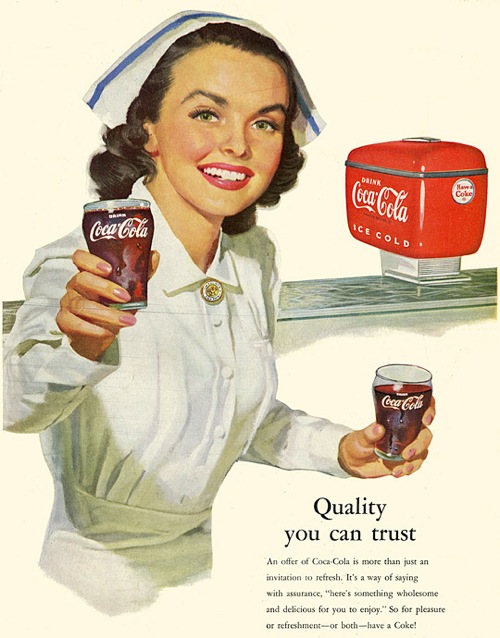
Featuring a pretty nurse offering glasses of Coke to the reader, this 1950s-era ad apparently attempts to portray Coca-Cola as a reliable and wholesome way for consumers to quench their thirst.
Coke was originally marketed as having health-giving properties. It started life as a patent medicine and purported cure for afflictions as wide-ranging as nerve trouble, morphine addiction and impotence. In the 1880s, pharmacist John Pemberton created the prototype recipe, which contained alcohol and coca leaf (the source of cocaine).
After prohibition came into force in Atlanta and Fulton County in 1886, Pemberton removed the alcohol and developed Coca-Cola itself. Interestingly, coca was still the main active ingredient until 1903, when it was replaced by caffeine.
9. “Coke on the Job Keeps Workers Refreshed!”
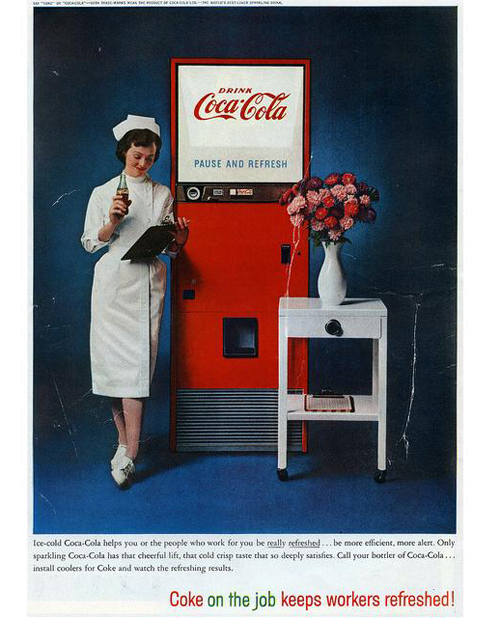
Coca-Cola’s high sugar content has led to reports that it is basically “liquid candy.” On top of this, links have been made between such sodas and obesity in the US population – yet some nurses and health professionals enjoy drinking it, despite the health risks. Maybe the burst of sugar and caffeine from the soft drink helps provide nurses with the much-needed energy to get through a long day.
Worryingly, a 2008 survey by the Nursing Times found that of the nurses who responded, over half confessed to being overweight, while 50 percent claimed that they were simply too busy to eat healthily. That said, flexible working hours, relocation opportunities and scope to perform different roles within the field are just a few of the benefits of this challenging yet rewarding profession.
8. “Sign of Good Taste”
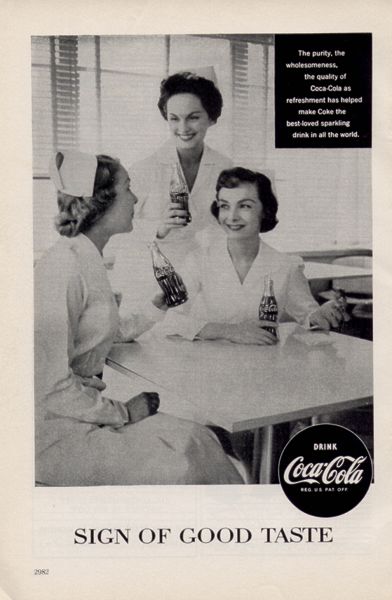
The text in the top-right corner of this ad reads, “The purity, the wholesomeness, the quality of Coca-Cola as refreshment has helped make Coke the best-loved sparkling drink in all the world.”
This kind of description, along with the use of nurses to promote the product, suggests that Coca-Cola is a healthy beverage. The audience may assume, if only subconsciously, that if nurses drink it, then it won’t do them any harm. In fact, though, modern studies have linked long-term soda consumption to increased risks of osteoporosis, high blood pressure and kidney problems.
Keen to shake off its unhealthy image, Coca-Cola released a commercial in 2013 stating that of its 650 drinks, 180 are now offered with low or zero calories. The company also plans to roll out smaller sized cans by the end of 2013 to help people with “portion control.” Yet while such efforts give consumers more options, it’s up to the general public to make the healthier choices.
7. “The Purity, the Wholesomeness, the Quality of Coca-Cola”
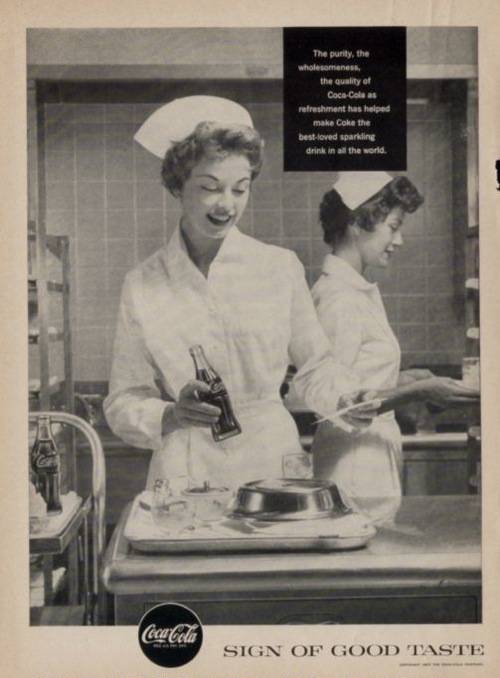
Coca-Cola advertising has a long history – and it has even erroneously been credited as having formed the modern representation of Santa Claus as an elderly man dressed in red and white during the 1930s. However, Coca-Cola’s original inventor John Pemberton is said to have had little knowledge of how to market his product effectively following its creation in 1886.
In fact, a secretary at Pemberton’s company called Frank Mason Robinson invented the beverage’s name and wrote it in the iconic Spencerian script still used on the packaging to this day. Robinson even came up with the first advertising slogan for the brand, “The pause that refreshes.”
6. “Something That Will Refresh You”
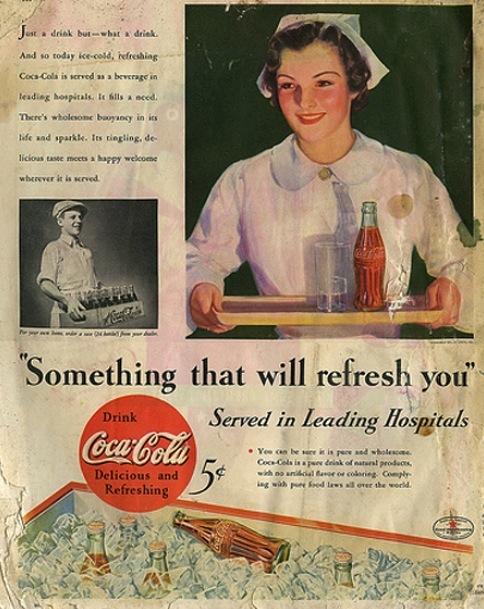
This Coca-Cola advert proudly claims that the product is “served in leading hospitals.” This seems to be an effort to suggest that the drink has met with the approval of the best medical establishments in the US and perhaps, by association, that it is even recommended to drink when feeling unwell.
From its humble origins as a patent medicine, Coke has become one of the most widely known drinks in the world. As of 2012, its Classic and Diet varieties made up 41 percent of the total soft drink market share worldwide.
Sodas like Coca-Cola are a very prominent source of empty calories (those lacking in nutritional value) in the American diet. Just one 20-ounce serving of Coke contains approximately 240 calories – 10 percent or more of a woman’s recommended daily allowance. And although Coca-Cola now ensures that its school vending machines mainly offer juices, waters and low-calorie drinks, selling sugary and high-calorie sodas remains at the heart of its business.
5. “Drink Coca-Cola”
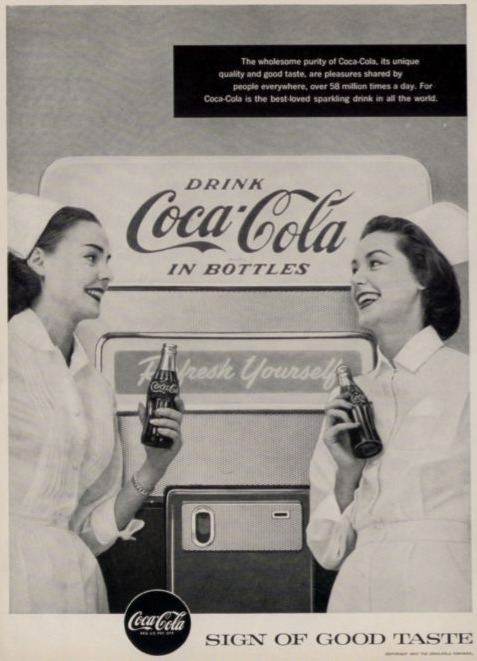
Mother Jones, a nurse, suggested on the blog Nurse Ratched’s Place that the days of socializing happily around the vending machine with a Coke are now over for nurses: “I vaguely remember when nurses had enough time to get off the floor and meet around the old Coca-Cola machine. You could get a bottle for 10 cents back then, and you had time to drink the whole bottle before you had to go back to work.
“Now no one has time to leave the unit for a soda, let alone lunch or dinner. There is a nursing shortage you know and nurses barely have time to take a restroom break.”
4. “Merci Bien”
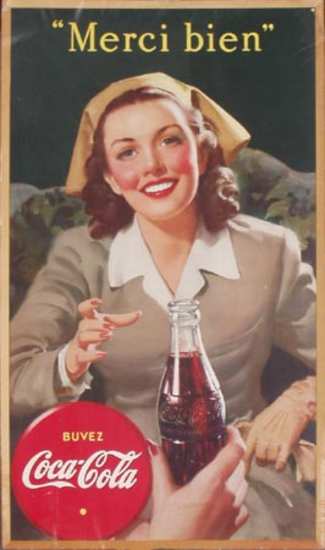
This vintage poster is thought to originate from 1940s Canada and depict a smiling nurse reaching for a bottle of Coke. It seems to associate Coca-Cola with happiness and cheer – also suggested by the poster’s slogan, “Merci Bien!”
Coke’s attempts at improving their products have not always gone down so well. Arguably one of the company’s biggest blunders was the introduction of New Coke in 1985. This revamped version the company’s flagship drink lasted for only a few months, as it garnered hundreds of thousands of letters and calls of complaint from the American public. The original formula was swiftly reintroduced under the moniker “Coca-Cola Classic,” until it eventually reverted back to Coke.
3. “At Ease… For Refreshment”
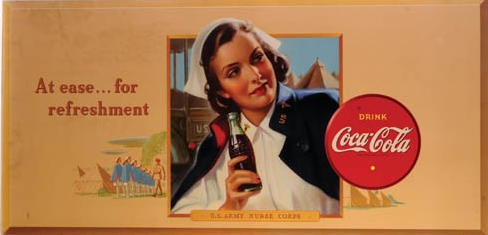
As this poster showing a US Army nurse suggests, Coca-Cola made substantial attempts to appeal to the forces during WWII. Indeed, as part of its drive to market itself as a patriotic company, it offered free beverages to soldiers – which also conveniently enabled it to avoid sugar-rationing laws. Company operatives were also allowed to be present on the front lines of battle as “Technical Officers,” although they rarely saw actual combat.
Interestingly, the company sold soft drinks to the other side, as well, with Fanta originally produced in Germany during the war. The recipe came about because of problems with importing the Coca-Cola syrup into the country thanks to restrictions on trade at the time.
2. “Work Refreshed”
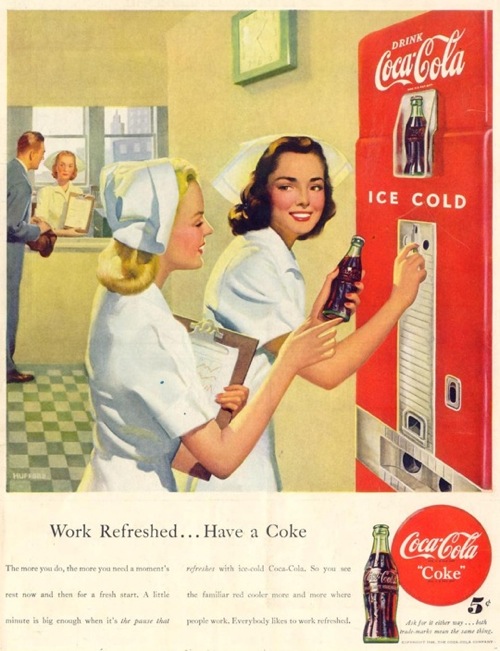
The ad above again suggests that Coca-Cola is the drink of choice for nurses. In the modern world, nurses are still frequently used to sell products; recent examples include a campaign for Virgin Mobile in India and controversial posters for a bus route in the West Midlands, England. Local nursing professionals have criticized the images on the bus route as demeaning for their depiction of a blond “nurse” in a skimpy uniform.
Although nowadays it’s unlikely that Coca-Cola would be offered as medicine, doctors have recently found that the fizzy drink can be helpful in treating a stomach blockage known as gastric phytobezoar. Why? Because its acidic chemicals, combined with the bubbles, can apparently dissolve the obstruction.
1. “You Trust Its Quality”

This 1954 advertisement asserts that Coca-Cola can be found in hospitals as well as stores and offices. And the cheerful nurse accompanying the text suggests that care providers are among those who trust the brand.
During the 1950s, efforts were made to promote Coke as a good drink for people with busy lifestyles; other ads included slogans such as “refreshing service for people on the go.” The period following WWII was one of great international progress for Coca-Cola, with the number of bottling plants worldwide increasing by almost 100 percent between the mid-1940s and 1960.
Interestingly, Coca-Cola wasn’t alone in using nurses to promote its product: its major competitor, Pepsi, also featured such healthcare professionals in its advertisements.



